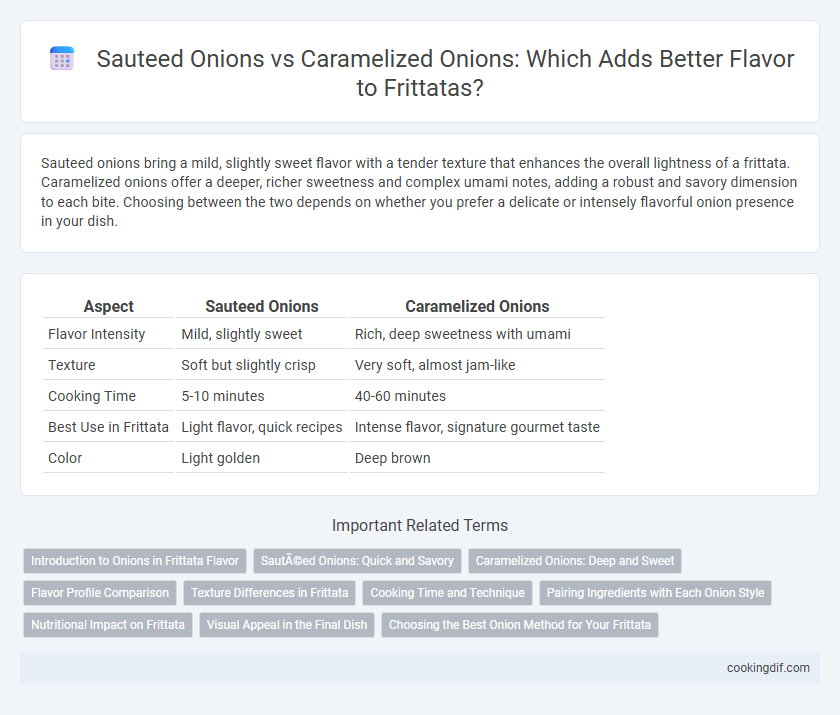Sauteed onions bring a mild, slightly sweet flavor with a tender texture that enhances the overall lightness of a frittata. Caramelized onions offer a deeper, richer sweetness and complex umami notes, adding a robust and savory dimension to each bite. Choosing between the two depends on whether you prefer a delicate or intensely flavorful onion presence in your dish.
Table of Comparison
| Aspect | Sauteed Onions | Caramelized Onions |
|---|---|---|
| Flavor Intensity | Mild, slightly sweet | Rich, deep sweetness with umami |
| Texture | Soft but slightly crisp | Very soft, almost jam-like |
| Cooking Time | 5-10 minutes | 40-60 minutes |
| Best Use in Frittata | Light flavor, quick recipes | Intense flavor, signature gourmet taste |
| Color | Light golden | Deep brown |
Introduction to Onions in Frittata Flavor
Sauteed onions in frittatas offer a mild, slightly sweet flavor with a tender texture that enhances the dish without overpowering other ingredients. Caramelized onions provide a deeper, richer sweetness and complexity due to prolonged cooking, contributing a savory, almost umami character. Choosing between sauteed and caramelized onions significantly impacts the overall flavor profile, allowing cooks to tailor their frittata to either a lighter or more robust taste experience.
Sautéed Onions: Quick and Savory
Sauteed onions offer a quick and savory flavor that enhances frittatas with a light, slightly sweet, and tender texture, achieved by cooking onions over medium-high heat for just a few minutes. This method preserves the onion's natural sharpness and adds a mild crunch, making it ideal for those seeking a more pronounced yet subtle onion presence. Unlike caramelized onions, which require longer cooking time and develop deep sweetness, sauteed onions provide a fresher, brighter taste that complements eggs without overwhelming other ingredients.
Caramelized Onions: Deep and Sweet
Caramelized onions provide a deep, sweet flavor that enhances the richness of a frittata, creating a complex taste profile with natural sugars developed through slow cooking. Unlike sauteed onions, which retain a sharper and more pungent bite, caramelized onions add a mellow, velvety texture and richness that complements eggs and cheese. Their slow-cooked sweetness balances savory ingredients, elevating the overall depth and satisfaction of the dish.
Flavor Profile Comparison
Sauteed onions in a frittata offer a mild, slightly sweet taste with a tender texture that enhances the dish without overpowering other ingredients. Caramelized onions provide a deeper, richer sweetness and a complex, almost umami flavor developed through slow cooking, adding a robust depth to the frittata. Choosing between sauteed and caramelized onions depends on whether a light, fresh onion essence or a pronounced, savory sweetness is desired for the flavor profile.
Texture Differences in Frittata
Sauteed onions add a crisp, slightly tender texture to frittatas, offering a subtle sweetness and a more pronounced onion bite. Caramelized onions provide a soft, jam-like consistency with deep, rich sweetness that blends seamlessly into the egg mixture. Choosing between sauteed and caramelized onions depends on whether a frittata requires more texture contrast or a smoother, velvety flavor profile.
Cooking Time and Technique
Sauteed onions, cooked over medium-high heat for about 5-7 minutes, offer a mild, slightly sweet flavor with a tender texture that complements the rich eggs in a frittata. Caramelized onions require low heat and slow cooking, typically 30-45 minutes, to develop deep, complex sweetness and a soft, jam-like consistency that intensifies the dish's flavor profile. Choosing between these techniques depends on the desired taste intensity and available cooking time for the frittata.
Pairing Ingredients with Each Onion Style
Sauteed onions bring a mild, slightly sweet flavor that pairs well with fresh herbs, tomatoes, and leafy greens in a frittata, enhancing the dish without overpowering other ingredients. Caramelized onions offer a rich, deep sweetness, complementing robust flavors like sharp cheeses, mushrooms, and savory meats such as sausage or bacon. Choosing between sauteed or caramelized onions depends on the desired flavor complexity and the other ingredients used to create a balanced, flavorful frittata.
Nutritional Impact on Frittata
Sauteed onions provide a milder flavor and retain more vitamin C and antioxidants in a frittata, supporting better nutrient preservation. Caramelized onions offer a richer, sweeter taste due to extended cooking, which reduces vitamin content but increases naturally occurring sugars and antioxidants from the Maillard reaction. Choosing between sauteed and caramelized onions in a frittata balances flavor complexity with varying nutritional profiles, depending on the desired health benefits and taste preference.
Visual Appeal in the Final Dish
Sauteed onions in a frittata maintain a lighter, translucent appearance that adds subtle texture and a mild sweetness, enhancing the dish's visual freshness. Caramelized onions develop a rich, deep brown color that creates a striking contrast and signals intense, savory flavor, making the frittata visually appealing with a gourmet touch. Choosing between sauteed or caramelized onions influences not only the flavor depth but also the overall presentation and color harmony on the plate.
Choosing the Best Onion Method for Your Frittata
Sauteed onions bring a mild sweetness and tender texture to a frittata, cooking quickly over medium-high heat to maintain brightness and subtle flavor. Caramelized onions develop deep, rich sweetness through slow cooking over low heat, adding a complex, savory depth perfect for enhancing the frittata's overall taste. Choosing between sauteed or caramelized onions depends on whether you prefer a lighter, fresher onion presence or a robust, intensely sweet flavor profile in your frittata.
Sautéed Onions vs Caramelized Onions for flavor Infographic

 cookingdif.com
cookingdif.com